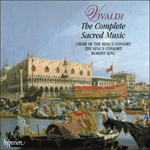
Welcome to Hyperion Records, a British classical label devoted to presenting high-quality recordings of music of all styles and from all periods from the twelfth century to the twenty-first.
Hyperion offers both CDs, and downloads in a number of formats. The site is also available in several languages.
Please use the dropdown buttons to set your preferred options, or use the checkbox to accept the defaults.

Unusually, the autograph manuscript leaves out the composer’s name. It likewise fails to identify the singer for whom it was composed, although that is less unexpected. In fact, the character of the contralto part and its accompaniment make it very likely that the singer was Geltruda (1684-1752), one of the Pietà’s leading musicians in the 1710s. Typically for a figlia di coro, Geltruda was active in more than a single capacity, being also a theorboist and a viola player. As a singer, she had a very narrow compass (the vocal part in RV633 stretches from Middle C only as far as the D a ninth above it) and a rather weak voice; a composer had to take care, as Vivaldi does, not to allow it to be drowned by the instruments. It is for this reason that when the contralto sings she is either accompanied by continuo alone or her part is doubled by violins.
from notes by ©
Chose inhabituelle, le manuscrit autographe omet le nom du compositeur et – ce qui est moins inattendu – celui de la chanteuse pour laquelle l’œuvre fut écrite. En réalité, et le caractère et l’accompagnement de la partie de contralto laissent à penser qu’il s’agissait très probablement de Geltruda (1684-1752), l’une des principales musiciennes de la Pietà des années 1710. En digne figlia di coro, Geltruda était une musicienne accomplie, théorbiste et altiste. Comme chanteuse, elle possédait un ambitus fort étroit (la partie vocale de RV633 va seulement de l’ut central au ré à la neuvième supérieure) et une voix plutôt faible; aussi tout compositeur devait-il prendre autant soin que Vivaldi de ne pas laisser les instruments noyer cette voix. Ce qui explique pourquoi la voix de contralto est soit accompagnée du seul continuo, soit doublée par les violons.
Le manuscrit nous apprend que Vivaldi substitua ultérieurement une nouvelle aria, «Prata, virete», à la seconde aria originelle, «Quid loqueris ad cor». Quoique douées toutes deux d’inflexions dansantes, ces arias sont assurément fort différentes: la première est dans une manière de forme «sérielle» (avec trois sections répétées, plus une coda), cependant que la seconde adhère au plan à da capo orthodoxe.
extrait des notes rédigées par Michael Talbot © 2001
Français: Hyperion Records Ltd
Ungewöhnlicherweise läßt die autographische Partitur den Namen des Komponisten weg. Auch die Sängerin, für die es komponiert wurde, wird nicht genannt, obwohl das weniger unerwartet ist. Tatsächlich machen der Charakter der Altpartie und deren Begleitung es sehr wahrscheinlich, daß es sich bei der Sängerin um Geltruda (1684-1752) handelte, eine der führenden Musikerinnen der Pietà in den Jahren nach 1710. Wie für eine figlia di coro üblich, war Geltruda in mehreren Funktionen tätig, nämlich auch als Theorbenspielerin und Bratschistin. Als Sängerin hatte sie einen sehr begrenzten Stimmumfang (der Gesangspart in RV633 reicht lediglich vom eingestrichenen C bis zum D eine None darüber) und eine recht zarte Stimme; ein Komponist mußte, wie es Vivaldi tat, darauf achten, daß sie nicht von den Instrumenten übertönt wurde. Aus diesem Grund wird die Altstimme bei ihren Einsätzen entweder vom Continuo allein begleitet, oder sie wird durch Geigen verdoppelt.
Aus dem Manuskript geht hervor, daß Vivaldi die ursprüngliche zweite Arie, „Quid loqueris ad cor“, später durch eine neue Arie mit dem Titel „Prata virete“ ersetzte. Die Arien, beide von tänzerischem Schwung gekennzeichnet, sind jedenfalls ganz verschieden: Die erste steht in einer Art Reihenform (mit drei wiederholten Abschnitten sowie einer Koda), während die zweite sich der orthodoxen Da-capo-Form bedient.
aus dem Begleittext von Michael Talbot © 2001
Deutsch: Anne Steeb/Bernd Müller
 Vivaldi: The Complete Sacred Music Vivaldi: The Complete Sacred Music‘For King's sterling service to the Vivaldian cause, one of his most important recording and satisfying projects to date, I am thankful’ (Gramophone) ‘If you're waiting for the perfect collection of Vivaldi's sacred music, this is it. It was a happy day when this beautiful boxed set arrived in my m ...» More |

